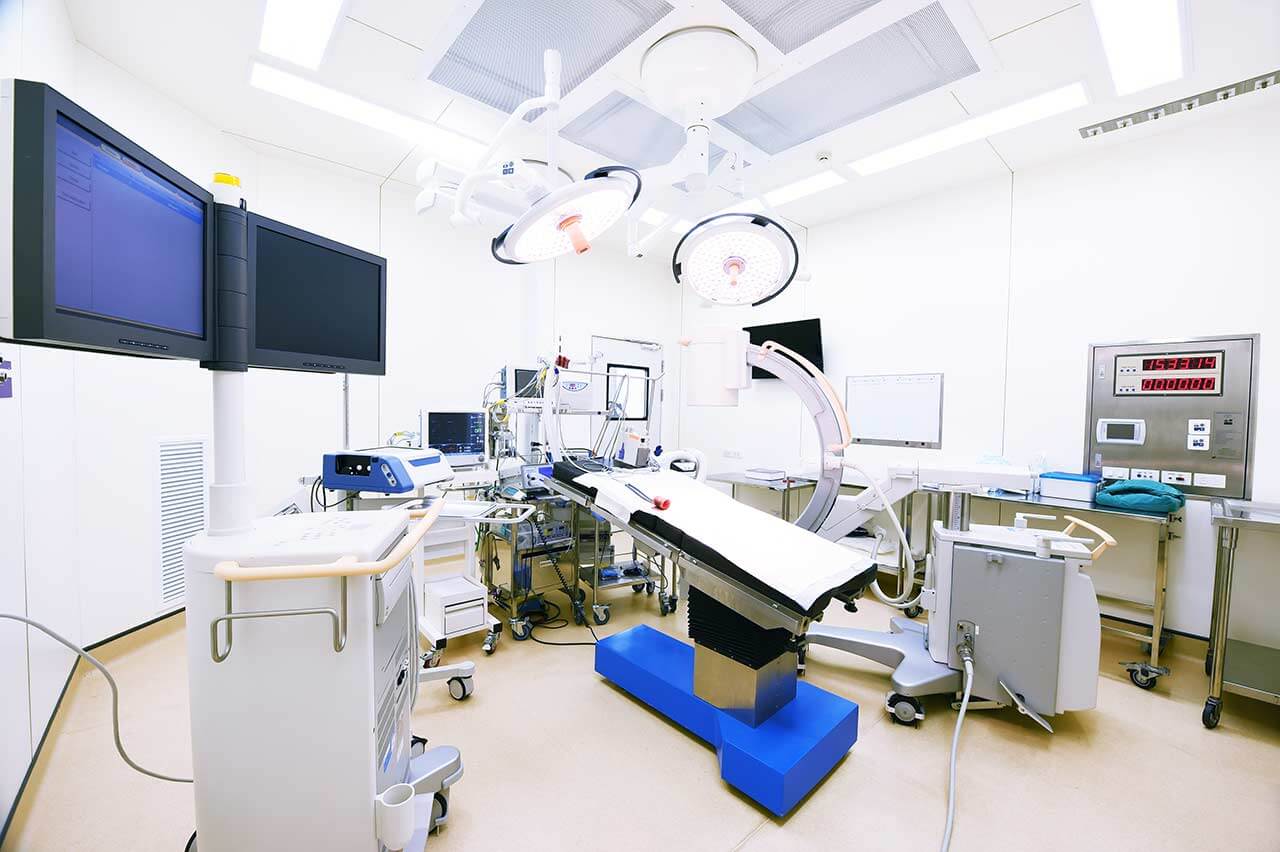
The program includes:
- Initial presentation in the hospital
- Clinical history taking
- Review of available medical records
- Physical examination
- Laboratory tests:
- Complete blood count
- General urine analysis
- Biochemical analysis of blood
- Tumor markers
- Inflammation indicators (CRP, ESR)
- Coagulogram
- Ultrasound scan
- CT scan / MRI
- Preoperative care
- Embolization or chemoembolization, 2 procedures
- Symptomatic treatment
- Cost of essential medicines
- Nursing services
- Elaboration of further recommendations
How program is carried out
During the first visit, the doctor will conduct a clinical examination and go through the results of the available diagnostic tests. After that, you will undergo the necessary additional examination, such as the assessment of liver and kidney function, ultrasound scan, CT scan and MRI. This will allow the doctor to determine which vessels are feeding the tumor and its metastases, as well as determine how well you will tolerate the procedure.
Chemoembolization begins with local anesthesia and catheterization of the femoral artery. The thin catheter is inserted through a few centimeters long incision of the blood vessel. The doctor gradually moves the catheter to the vessel feeding the primary tumor or its metastases. The procedure is carried out under visual control, an angiographic device is used for this. The vascular bed and the position of the catheter in it are displayed on the screen of the angiograph.
When the catheter reaches a suspected artery, a contrast agent is injected through it. Due to the introduction of the contrast agent, the doctor clearly sees the smallest vessels of the tumor and the surrounding healthy tissues on the screen of the angiograph. After that, he injects emboli into the tumor vessels through the same catheter.
Emboli are the spirals or the liquid microspheres. The type of embolus is selected individually, taking into account the diameter of the target vessel. When carrying out chemoembolization, a solution of a chemotherapy drug is additionally injected into the tumor vessel. Due to the subsequent closure of the vessel lumen with an embolus, the chemotherapy drug influences the tumor for a long time. In addition, the drug does not enter the systemic circulation, which allows doctors to use high doses of chemotherapeutic agents without the development of serious side effects. Chemoembolization leads to the destruction of the tumor or slowing down its progression.
After that, the catheter is removed from the artery. The doctor puts a vascular suture on the femoral artery and closes it with a sterile dressing. During chemoembolization, you will be awake. General anesthesia is not used, which significantly reduces the risks of the procedure and allows performing it on an outpatient basis, avoiding long hospital stay.
After the first procedure, you will stay under the supervision of an interventional oncologist and general practitioner. If necessary, you will receive symptomatic treatment. As a rule, a second chemoembolization procedure is performed in 3-5 days after the first one in order to consolidate the therapeutic effect. After that, you will receive recommendations for further follow-up and treatment.
Service
You may also book:
 BookingHealth Price from:
BookingHealth Price from:
About the department
According to the Focus magazine, the Department of Adult and Pediatric Urology at the University Hospital Bonn ranks among the top German departments specializing in prostate cancer treatment!
The department deals with the diagnostics, conservative and surgical treatment of diseases of the genitourinary system in men and boys. If necessary, surgical treatment may be provided with the use of sparing minimally invasive techniques, which allows to ensure early recovery for the patient. In the treatment of benign prostatic hyperplasia, kidney stone disease, ultramodern laser technologies are widely used. The department treats more than 1,800 inpatients and about 5,000 outpatients every year. The Chief Physician of the department is Prof. Dr. med. Manuel Ritter.
In the field of pediatric urology, the department successfully treats congenital urologic defects, hypospadias, phimosis, undescended testes, urinary incontinence. All treatments comply with the international standards, and therefore guarantee the best outcome of therapy. The therapeutic options encompass both surgical interventions and conservative treatment with modern medicines.
The service range of the department includes:
- Diagnostics and treatment of prostate cancer
- Diagnostics and treatment of kidney cancer
- Minimally invasive surgery
- Reconstructive surgery and conservative treatment of urinary incontinence (also in women)
- Drug therapy
- Physiotherapeutic measures
- Surgical treatment (for example, artificial sphincter implantation, comprehensive reconstructive operations in women using the PROLIFT® Netz technology)
- Endourology
- Endoscopy of the entire urinary tract (urethra, bladder, ureters and renal pelvis)
- Photodynamic diagnostics for bladder tumors and underlying precancerous conditions
- Videodynamic studies
- Laser technologies (for example, RevoLix® laser for the treatment of benign prostatic hyperplasia)
- Diagnostics and treatment of pediatric urologic pathologies
- Congenital malformations
- Hypospadias
- Undescended testicle (cryptorchidism)
- Phimosis
- Urinary incontinence
- Impaired urine outflow
- Vesicoureteral reflux
- Neurourology
- Drug therapy
- Exercises to strengthen pelvic floor muscles (Biofeedback)
- Instillation therapy for bladder diseases
- Injection therapy for urethral dysfunction
- Botulinum toxin injection therapy for urinary incontinence
- Botulinum toxin injection therapy for impaired urine outflow / prostatitis
- Botulinum toxin injection therapy for benign prostatic hyperplasia
- Surgical treatment of urinary incontinence
- Neuromodulation and neurostimulation
- Implantation of an artificial sphincter of the bladder
- Diagnostics and treatment of kidney stone disease (the main treatment is is extracorporeal shock wave lithotripsy)
- Andrology
- Diagnostics and treatment of erectile dysfunction
- Diagnostics and treatment of hormonal disorders in men
- Diagnostics and treatment of infertility
- Other medical services
Curriculum vitae
Prof. Dr. med. Manuel Ritter is the Head of the Department of Adult and Pediatric Urology at the University Hospital Bonn. He is the successor to the famous urologist Stefan Müller. Prior to joining the University Hospital Bonn, he served as a Managing Senior Physician in the Department of Urology at the University Hospital Mannheim. The main clinical and research focuses of Dr. Ritter cover imaging diagnostics and minimally invasive treatment of uro-oncological pathologies. At the same time, much attention is paid to the preservation of organ functionality (for example, potency). Also, Prof. Ritter specializes in carrying out laser procedures for the treatment of diseases of the male genitourinary system.
Photo of the doctor: (c) Universitätsklinikum Bonn
About hospital
According to the authoritative Focus magazine, the University Hospital Bonn ranks among the top ten medical facilities in Germany!
The hospital was opened on January 1, 2001, although in fact it inherits the medical facility, which operated at the Faculty of Medicine of the University of Bonn. The hospital in Germany combines all the highest standards of modern university medicine of the international level. A highly competent team of experienced physicians, which consists of more than 8,000 employees from various fields, takes care of the patients’ health.
The hospital has 32 specialized departments and 23 institutes, which implement the highest standards of treatment in Germany. On their basis, in addition to the successful clinical activities, the productive research and training of young specialists are carried out. Also, the hospital has 10 intensive care units and more than 30 cutting-edge operating rooms. They are equipped with the advanced surgical, navigation and monitoring systems, which provide sparing and the most effective surgical treatment. The total number of places for hospitalization is 1,250 beds.
The hospital presents all fields of medicine, while many of them are awarded by prestigious German and international certificates. For example, in 2007, the Comprehensive Cancer Center of the hospital became one of the four winners at the nationwide competition among Cancer Centers of Excellence. The research focuses primarily on the clinical genetics and genetic epidemiology, neurology, immunology and infectiology, hepatology and gastroenterology, and diseases of the cardiovascular system. The research findings contribute to the development of new therapeutic methods and overall improvement of treatment in Germany.
The main value for all employees of the hospital in Germany is human health, his individual needs and wishes, therefore, despite the high-tech infrastructure, the focus remains on the human attitude and respect for each patient.
Photo: (с) depositphotos
Accommodation in hospital
Patients rooms
The patients of the University Hospital Bonn live in cozy single, double and triple rooms, designed in bright colors. The standard room furnishing includes a comfortable bed with a remote control, a bedside table, a wardrobe, a table and chairs, as well as a TV and a telephone. Each patient room is equipped with an ensuite bathroom with toilet and shower. The hospital also provides enhanced-comfort rooms.
Meals and Menus
The patients of the hospital are offered tasty and balanced three meals a day: breakfast, lunch and dinner. Every day each meal features three different menus, including a vegetarian one. If you for some reason do not eat all the food, you will be offered an individual menu. Please inform the medical staff about your dietary preferences prior to the treatment.
Further details
Standard rooms include:
Religion
Christian priests are available for the patients at any time. Representatives of other religions may be requested at any time.
Accompanying person
Your companion may stay with you in your room or at a hotel of your choice during the fixed program.
Hotel
You may stay at the hotel during the outpatient program. Our employees will support you for selecting the best option.
The hospital offers a full range of laboratory tests (general, hormonal, tests for infections, antibodies, tumor markers, etc.), genetic tests, various modifications of ultrasound scans, CT scans, MRI and PET / CT, angiography, myelography, biopsy and other examinations. Treatment with medications, endoscopic and robotic operations, stereotaxic interventions is carried out here, modern types of radiation therapy are also used. The hospital offers patients all the necessary therapeutic techniques.
- Surgical treatment of the brain tumors, tumors of spinal cord and spine
- Replacement of all joints, resection arthroplasty
- Deep brain stimulation and vagus nerve stimulation in patients with epilepsy
- Multimodal complex treatment of Parkinson disease
- Thoracic endovascular aortic repair (TEVAR)
These are benign and malignant breast pathologies, malignant tumors of various localizations, neuromuscular diseases, stroke, retinal pathologies and various visual impairments, infertility, autoimmune diseases, epilepsy, coronary artery disease and myocardial infarction, leukemia and other pathologies.
- Ophthalmology
- Epileptology
- Reproductive medicine
- Hematology and oncology
- Neurosurgery
Over 8,000 highly qualified doctors and other employees work at the hospital.





